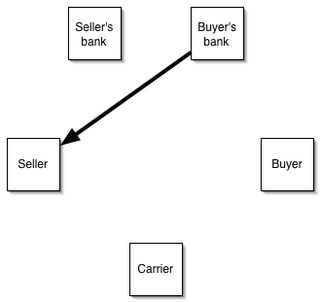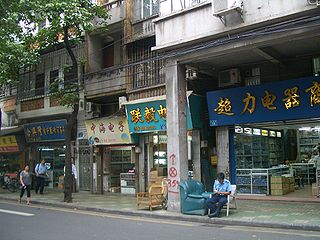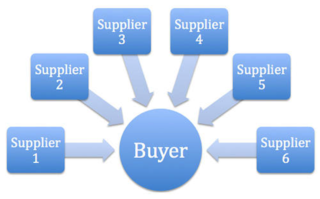Discounts and allowances are reductions to a basic price of goods or services.
In business or commerce, an order is a stated intention, either spoken or written, to engage in a commercial transaction for specific products or services. From a buyer's point of view it expresses the intention to buy and is called a purchase order. From a seller's point of view it expresses the intention to sell and is referred to as a sales order. When the purchase order of the buyer and the sales order of the seller agree, the orders become a contract between the buyer and seller.
A request for proposal (RFP) is a document that solicits a proposal, often made through a bidding process, by an agency or company interested in procurement of a commodity, service, or valuable asset, to potential suppliers to submit business proposals.
Procurement is the process of locating and agreeing to terms and purchasing goods, services, or other works from an external source, often with the use of a tendering or competitive bidding process. The term may also refer to a contractual obligation to "procure", i.e. to "ensure" that something is done. When a government agency buys goods or services through this practice, it is referred to as government procurement or public procurement.
An invoice, bill or tab is a commercial document issued by a seller to a buyer relating to a sale transaction and indicating the products, quantities, and agreed-upon prices for products or services the seller had provided the buyer.

A letter of credit (LC), also known as a documentary credit or bankers commercial credit, or letter of undertaking (LoU), is a payment mechanism used in international trade to provide an economic guarantee from a creditworthy bank to an exporter of goods. Letters of credit are used extensively in the financing of international trade, when the reliability of contracting parties cannot be readily and easily determined. Its economic effect is to introduce a bank as an underwriter that assumes the counterparty risk of the buyer paying the seller for goods.
Purchasing is the procurement process a business or organization uses to acquire goods or services to accomplish its goals. Although there are several organizations that attempt to set standards in the purchasing process, processes can vary greatly between organizations.
E-procurement is the business-to-business or business-to-consumer or business-to-government purchase and sale of supplies, work, and services through the Internet as well as other information and networking systems, such as electronic data interchange and enterprise resource planning.

Business-to-business is a situation where one business makes a commercial transaction with another. This typically occurs when:
Strategic sourcing is the process of developing channels of supply at the lowest total cost, not just the lowest purchase price. It expands upon traditional organisational purchasing activities to embrace all activities within the procurement cycle, from specification to receipt, payment for goods and services to sourcing production lines where the labor market would increase firms' ROI. Strategic sourcing processes aim for continuous improvement and re-evaluation of the purchasing activities of an organisation.
B2B e-commerce, short for business-to-business electronic commerce, is the sale of goods or services between businesses via an online sales portal. In general, it is used to improve the efficiency and effectiveness of a company's sales efforts. Instead of receiving orders using human assets manually – by telephone or e-mail – orders are received digitally, reducing overhead costs.
A blanket order, blanket purchase agreement or call-off order is a purchase order which a customer places with its supplier to allow multiple delivery dates over a period of time, often negotiated to take advantage of predetermined pricing. It is normally used when there is a recurring need for expendable goods. Blanket orders are often used when a customer buys large quantities and has obtained special discounts. Based on the blanket order, sales orders and invoice items can be created as needed until the contract is fulfilled, the end of the order period is reached or a pre-determined maximum order value is reached.
Procurement software refers to a range of business software designed to streamline and automate purchasing processes for businesses and organizations. By managing information flows and transactions between procuring entities, suppliers, and partners, procurement software aims to cut costs, improve efficiency, and boost organizational performance.
Purchasing is the formal process of buying goods and services. The purchasing process can vary from one organization to another, but there are some common key elements.
Government procurement or public procurement is undertaken by the public authorities of the European Union (EU) and its member states in order to award contracts for public works and for the purchase of goods and services in accordance with principles derived from the Treaties of the European Union. Such procurement represents 13.6% of EU GDP as of 2018, and has been the subject of increasing European regulation since the 1970s because of its importance to the European single market.
The term Public eProcurement refers, in Singapore, Ukraine, Europe and Canada, to the use of electronic means in conducting a public procurement procedure for the purchase of goods, works or services.
Government procurement in Russia relates to the public procurement in Russia by all governmental, regional and local authorities. The government procurement in Russia represents a big segment of the budgetary expenses. The volume of government purchases makes about 25 trillion rubles in 2015 and 30 trillion rubles in 2016. The government purchases system is constantly modernized due to changes in legislation, technical components and information.

A reverse auction is a type of auction in which the traditional roles of buyer and seller are reversed. Thus, there is one buyer and many potential sellers. In an ordinary auction also known as a forward auction, buyers compete to obtain goods or services by offering increasingly higher prices. In contrast, in a reverse auction, the sellers compete to obtain business from the buyer and prices will typically decrease as the sellers underbid each other.

An invitation to tender is a formal, structured procedure for generating competing offers from different potential suppliers or contractors looking to obtain an award of business activity in works, supply, or service contracts, often from companies who have been previously assessed for suitability by means of a supplier questionnaire (SQ) or pre-qualification questionnaire (PQQ).
There are many types of e-commerce models', based on market segmentation, that can be used to conducted business online. The 6 types of business models that can be used in e-commerce include: Business-to-Consumer (B2C), Consumer-to-Business (C2B), Business-to-Business (B2B), Consumer-to-Consumer (C2C), Business-to-Administration (B2A), and Consumer-to-Administration




